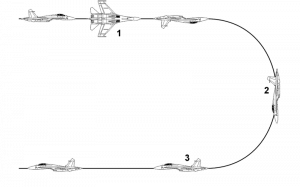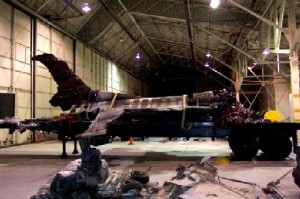Ejection 0.8 Seconds Before Impact
The incident happened in 2003 but I only just saw the photograph and video on /r/aviation last week.

This looks like a photoshopped picture or a stunt still from of a Hollywood movie but it is 100% legitimate.
The photograph was taken at the Mountain Home Air Force Base in Idaho, where the Thunderbirds were putting on an aerial display. The photographer snapped this photograph of 31-year-old Captain Chris Stricklin from the tower, capturing the exact moment when Captain Stricklin ejected from the F-16. Stricklin ejected less than a second before the F16 hit the ground.
The Thunderbirds are the air demonstration squadron of the United States Airforce, the equivalent of the Red Arrows of the UK Royal Air Force or the Blue Angels of the US Navy.
The Thunderbirds were formed in 1917 as an operational squadron. In 1953 they became the aerobatic display team in 1953, taking the name Thunderbirds from the southwestern US folklore around Luke Air Force Base, Arizona. They became the world’s first supersonic aerial demonstration team in 1956 but had to stop after the FAA banned all supersonic flight at air shows.
They tour the US and the world to perform air demonstrations but they apparently are able to rapidly integrate into an operational fighter unit. They fly F16 Fighting Falcons.
Their standard demonstration is documented on Wikipedia:
From the end of the runway the 4-ship Thunderbird team get ready to begin their take-off roll with the words “Thunderbirds, let’s run em up!” being retransmitted from the team leader’s mic through the PA system for the crowd to hear.
Diamond: Historically, as Thunderbirds 1 through 4 lift off, the slot aircraft slips immediately into position behind 1 to create the signature Diamond formation. Thanks to the 2009 upgrade to the Block 52, the Diamond now has more than enough thrust to continue to climb straight up into their first maneuver, the Diamond Loop.
Solos: Thunderbird 5 takes to the air next performing a clean low altitude aileron roll followed by 6 who performs a split S climbing in a near vertical maneuver rolling over and diving back toward show center pulling up just above the runway and exiting in the opposite direction.
Much of the Thunderbirds’ display alternates between maneuvers performed by the diamond, and those performed by the solos. They have a total of 8 different formations: The Diamond, Delta, Stinger, Arrowhead, Line-Abreast, Trail, Echelon and the Five Card. The arrowhead performs maneuvers in tight formation as close as 18 inches Fuselage to Canopy separation. They perform formation loops and rolls or transitions from one formation to another. All maneuvers are done at speeds of 450-500+ mph.
Stricklin was flying Thunderbird 6, performing the Split S manoeuvre as a part of his solo performance with the Thunderbirds.
The Split S (known in the RAF as the Half Roll and in the Luftwaffe as the Abschwung) is a dog-fighting technique used to disengage from combat. The pilot half-rolls his aircraft so that he’s flying upside down and then dives away in a descending half-loop, pulling out so that he’s flying straight and level in the opposite direction.
At the Mountain Home airshow as that Captain Stricklin did not have enough vertical space to pull out of the half-loop, leading to his last-second ejection. He had performed the Split S manoeuvre over two hundred times.
The astounding photograph was taken by a professional photographer at the control tower and was swiftly leaked to the public despite the fact that the military immediately locked down into an investigation. The photographer posted on the f-16.net message boards.
Thunderbird crash photo (head-on)
I have noticed all over the internet the shot I had taken of the Thunderbird crash at Mountain Home AFB, ID and though I am not at liberty to share the photo; it is out there. I would like to end some speculation and let you know the photo is real.
I’m a Still Photographer for the USAF and I was stationed at MHAFB during the air show. I was on the catwalk of the tower at Mtn Home along with another photog (video) and about seven other (military) spectators. I have shot the T-birds from the tower before and I was pretty excited to do it again (the sky was perfect blue). I followed Thunderbird 6 from takeoff and watched as he pulled into his maneuver. I then noticed something seemed to be wrong, his direction was a little off; he was pulling out and heading right towards the tower. At this point I figured two things: 1. He’s either going to fly past this tower and we’ll feel the heat or 2. This is going to be ugly… I waited for the aircraft to level and clicked the shutter, what I saw through the lens will never go away…
At the same time as I shot I seen a flash of light and horrific sound. I was shooting on high speed continuous and the next couple frames were a ball of fire and my feet, right before I ran. We all ran to the other side of the tower, I tried to get everyone in along with my partner and finally made it in myself. By the time we got inside the 16 had stopped sliding and rested about 100 ft in front of the tower. I then continued documenting the work of our base firefighters as they put out the flames. It was an experience and though I can’t officially make any comments to the matter, I would like to say Capt Stricklin saved lives… enough said.
For those who are wondering the image is not cleared for public release.
Also for those fellow photogs I was shooting with a D1x with a 300mm, 2.8 @ 1000 and 2000
Thanks,
SSgt Bennie J. Davis III
Still Photographer, USAF
The photograph was officially released a few days later, along with the video from the cockpit just before the crash.
Redditors have pointed out that his left arm twitches twice towards the eject lever before committing to the action.
Captain Stricklin sustained only minor injuries. The $20.4 million F16 was destroyed.
This video shows the view from the crowd:
The investigation results were released as a press release a year later:
PRESS RELEASE — Secretary of the Air Force, Directorate of Public Affairs
Release No. 0121045 – Jan 21, 2004
Thunderbirds Accident Report Released
LANGLEY AIR FORCE BASE, Va. – Pilot error caused a U.S. Air Force Thunderbirds F-16 aircraft to crash shortly after takeoff at an air show Sept. 14 at Mountain Home Air Force Base, Idaho.
The pilot ejected just before the aircraft impacted the ground.According to the accident investigation board report released today, the pilot misinterpreted the altitude required to complete the “Split S” manoeuvre. He made his calculation based on an incorrect mean-sea-level altitude of the airfield. The pilot incorrectly climbed to 1,670 feet above ground level instead of 2,500 feet before initiating the pull down to the Split S manoeuver.
When he realized something was wrong, the pilot put maximum back stick pressure and rolled slightly left to ensure the aircraft would impact away from the crowd should he have to eject. He ejected when the aircraft was 140 feet above ground — just eight –tenths of a second prior to impact. He sustained only minor injuries from the ejection. There was no other damage to military or civilian property.
The aircraft, valued at about $20.4 million, was destroyed.
Also, the board determined other factors substantially contributed to creating the opportunity for the error including the requirement for demonstration pilots to convert mean sea level and above ground level altitudes and performing a manoeuvre with a limited margin of error.
For more information, contact the ACC Public Affairs office at (757) 764-5007 or e-mail [email protected].
The QNH (sea-level altitude) vs QFE (altitude above the ground) is thus seen as a contributing factor.
Stricklin’s home base at Nellis is at 2,000 feet whereas Mountain Home is at 3,000 feet, so the altitude he selected would have been correct at his home base.
The contributing factor of requiring pilots to convert sea-level altitude information to altitude above ground for radio calls was immediately dealt with by the Air Force. Thunderbird pilots now call out MSL (Mean Sea Level) altitudes rather than AGL (Above Ground Level) altitudes and must climb an additional one thousand feet before performing the Split S manoeuvre.
A bystander reported that after the ejection, Stricklin stood silently by the canopy of the aircraft. Then he threw his helmet at the ground and stomped over to the wreckage. He knew that his time as a Thunderbird pilot was over.
However, I was pleased to see that in 2009, Stricklin was commended for his work on safety programmes in the USAF:
2009: CSAF Individual Safety Award – Lt. Col. Christopher Stricklin, 14th Flying Training Wing, Columbus Air Force Base, Miss.
Colonel Stricklin led and managed flight, ground, and weapon safety programs for 3,000 personnel, including 20 essential safety personnel who provided over 3,120 annual hours of on-call service. As a direct result of his efforts, flight mishaps were reduced in nearly every category; down 50 percent in Class A, 70 percent in Class C, 44 percent in Class E, and 50 percent in Controlled Movement Area Violations.
It makes sense to me; if I’d been that close to smashing into the ground, I’d be pretty thoughtful about flight safety too!










I just found out about this terrible mistake via a photo on wikipedia. Even though it was pilot error and Lt. Col. Stricklin was obviously extremely mad at himself over what happened, it seems that the incident has helped him discover excellence in helping prevent mistakes and save lives. Sometimes what seems like the worst thing in the world can end up bringing you to an even better place–which is how I hope Lt. Col. Stricklin sees it today.
Thank you Samir, for your kind and encouraging words. We are the product of our experiences, both good and bad. Today is the result of decisions, actions, reactions and inactions of yesterday. It took me 16 years, but I am finally able to tell my story in a book publishing 1 Oct 19. Survivor’s Obligation is not about why I crashed, it is about why I survived & how it has impacted my life!
http://www.ChrisStricklin.com
What an amazing story Col Stricklin!
Don’t miss his story in Survivor’s Obligation which I wrote about here: https://fearoflanding.com/military/survivors-obligation/
Thank you, Capt Stricklin, for writing a remarkable book. Thoroughly enjoyed reading it. Have been following your incident since 2003. I too have been a fighter jock for over 33 years and made all sorts of mistakes. Lived through 2 ejections and almost got killed by GLOC in a Mirage. But your story is a lesson for all: Plan well and then Never give up and Never give in. I have two sons as combat pilots, Squadron Leader Fahad is your acquaintance. Wish you and family all the health and happiness.
Thank you Sir, for your comments and your dedication to aviation!
Probably one great contribution to flight safety is to ban high risk stunts in public air-shows, like they did for supersonic flights. I do not think that spectators will be less thrilled if the distance between planes is increased 5 times ?. Finally, 18 inches times 5 is not even 100 inches, and this is damn close when flying at 500 mph